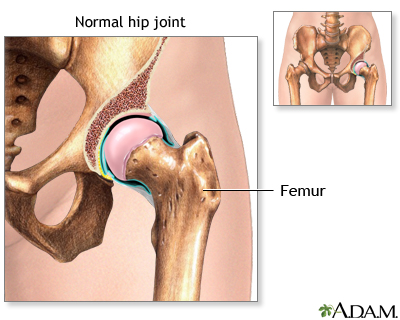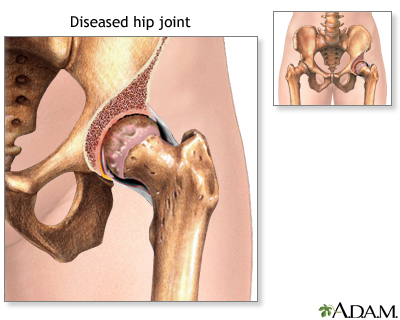Health exams for: #AGEGROUP#
The following exams, tests, and procedures are recommended for #AGEGROUPLOWER#.#FEMALETEXT#
Select a link from the list below to learn how and why each test is performed, as well how to prepare for it.

The following exams, tests, and procedures are recommended for #AGEGROUPLOWER#.#FEMALETEXT#
Select a link from the list below to learn how and why each test is performed, as well how to prepare for it.





The hip joint is a ball-in-socket joint where the ball or head of the femur (thigh bone) joins the pelvis at the socket called the acetabulum.
The hip joint is a ball-in-socket joint where the ball or head of the femur (thigh bone) joins the pelvis at the socket called the acetabulum.
Hip Joint Replacement or Total Hip Replacement is surgery to replace all or part of the hip joint with an artificial device to restore joint movement (a prosthesis).
Hip Joint Replacement or Total Hip Replacement is surgery to replace all or part of the hip joint with an artificial device to restore joint movement...
The hip is a ball and a socket joint, linking the ball at the head of the thigh bone (femur) and the cup in the pelvic bone. A total hip prosthesis is surgically implanted to replace the damaged bone within the hip joint. The total hip prosthesis consists of three parts a plastic (sometimes metal) cup that replaces the hip socket (acetabulum), a metal ball that will replace the femoral head, a metal stem that is attached to the shaft of the bone to add stability to the prosthesis. If a hemi-arthroplasty is performed, either the femoral head or the hip socket (acetabulum) will be replaced with a prosthetic device. You will receive an extensive pre-operative evaluation of your hip to determine if you are a candidate for a hip replacement procedure. Evaluation will include assessment of the degree of disability and impact on your lifestyle, pre-existing medical conditions, and an evaluation of heart and lung function. The surgery will be performed using general or spinal anesthesia. The orthopedic surgeon makes an incision along the affected hip joint, exposing the hip joint. The head of the femur and the cup are cut out and removed.
The hip is a ball and a socket joint, linking the ball at the head of the thigh bone (femur) and the cup in the pelvic bone. A total hip prosthesis i...
Then a metal ball and the metal stem is inserted in the femur (thigh bone) and a plastic socket is placed in the enlarged pelvis cup. The artificial components are fixed in place (sometimes a special cement is used). The muscles and tendons are then replaced against the bones and the incision is closed. You will return from surgery with a large dressing to the hip area. A small drainage tube will be placed during surgery to help drain excess fluids from the joint area.
Then a metal ball and the metal stem is inserted in the femur (thigh bone) and a plastic socket is placed in the enlarged pelvis cup. The artificial ...
You will experience moderate to severe pain after surgery. However, patient-controlled analgesia (PCA), intravenous (IV), or epidural analgesics are effective in controlling post-operative pain. The pain should gradually decrease, and by the third day after surgery, oral analgesic medications may be sufficient to control your pain. Try to schedule your pain medications about one half hour before walking or changing position. Results with a hip prosthesis have been excellent. The operation relieves pain and stiffness symptoms, and most patients (over 80%) need no help walking. With time, loosening of the artificial joint may occur because of the limited properties of the cement used to attach the artificial parts to the bones. You will remain in the hospital for up to a week after surgery. The use of crutches or a walker is necessary at the start of rehabilitation. However, some people may need further rehabilitation and assistance after hip replacement surgery. Temporary placement in a rehabilitation unit or long-term care center may be necessary until mobility has improved and the person can safely live independently. These centers will provide intensive physical therapy to assist in regaining muscle strength and flexibility in the joint. Positioning is very important after surgery to reduce stress on the new joint and displacement of the joint. The new hip will not have the same range of movement of the original joint, although you should eventually be able to return to your previous level of activity. However, you should avoid vigorous or high impact sports, such as skiing or contact sports. SPECIAL PRECAUTIONS. The new joint has a limited range of movement. Until your joint has healed, you will need to take special precautions to avoid dislocation of the joint, including avoid crossing your legs or ankles even when sitting, standing, or lying; When sitting, keep you feet about 6 inches apart; When sitting, keep your knees below the level of your hips. Avoid chairs that are too low. You may sit on a pillow to keep your hips higher that your knees. When getting up from a chair, slide toward the edge of the chair and then use your walker or crutches for support. Avoid bending over at the waist. You may consider purchasing a long-handled shoehorn or a sock aid to help you put on and take off your shoes and socks without bending over. Also, a extension reacher or grabber may be helpful for picking up objects that are too low for you to reach. When lying in bed, place a pillow between your legs to keep the joint in proper alignment. A special abductor pillow or splint may be used to keep the hip in correct alignment. An elevated toilet seat may be necessary to keep the knees lower than the hips when sitting on the toilet.
You will experience moderate to severe pain after surgery. However, patient-controlled analgesia (PCA), intravenous (IV), or epidural analgesics are ...
Review Date: 1/24/2018
Reviewed By: Andrew W. Piasecki, MD, Camden Bone and Joint, LLC, Orthopaedic Surgery/Sports Medicine, Camden, SC. Review provided by VeriMed Healthcare Network. Also reviewed by David Zieve, MD, MHA, Medical Director, Brenda Conaway, Editorial Director, and the A.D.A.M. Editorial team.
